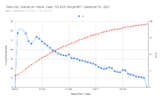I do mot know if you know but to make this sure:Sorry to disappoint you, but although I don't believe nearly anything I read, I don't keep track of the stories I do. It's the internet, not a dissertation. All I can tell you is the range on my LR was WAAAAY lower than advertised under every condition, so seemed plausible to me. And could have been that 'buffer', for all I know. And Apple was sued (and settled out of court, and offered owners free battery replacement... which I got) for doing something to decrease battery life, to force owners to upgrade to a new phone. If you care that much about both stories, search. And VW cheated with the diesel emissions, and got caught too. Unless you're in kinder garten, it's nothing new.
- EV manufacturers must presebt the range acvording to EPA. There are a possibility to make a volantary Reduction, but if the test shows for example 315 miles, then the car will do this on the dsy of delivery.
- The EPA (and WLTP) test is performed at 23C with the AC off. (My logged data for both cars show the longest range between 20 abd 25C so it is actually on the best temperature for an EV).
-The range is not tested at 80mph constant speed. The aversge speed is much less.
- Batteries degrade heavily the first year, specially the first six months. If ypu are a average EV owner, you loose ~ 5% the firdt year = 5% range lost.
If you take your brand new car and drive in +23C with the AC off at 55mph on telatively flat ground you’ll be able to drive the EPA range. As the EPA range is tested until the car stops you also need to drive until the car stops. In this case, you need to distegard the 0% displayed as you still have a out 4.5% below that to drive on.
I did slightly more than the EPA range after my car was 1.5 yrs and about 40K km.
Got 319 miles/513km out of the 315mi/507km EPA range.
I actually drove the first half (240km to work) exactly by the speed limit, and on the way home I used the cruise control spreed set to estimate to arrive at home with 0% indicated. The last 30km it was dense fog so I had to refuce the speed. I ended up driving another 33km around town to get to 0%.



